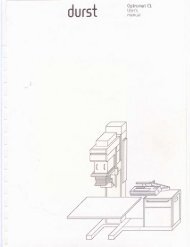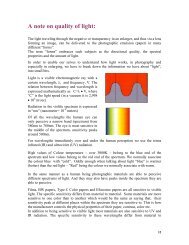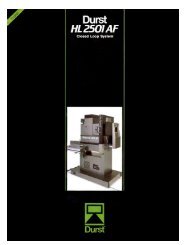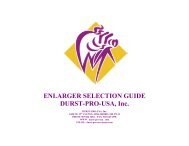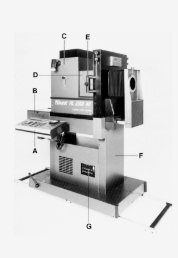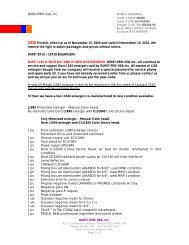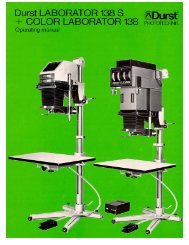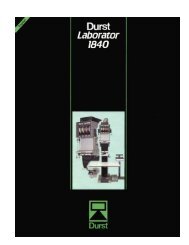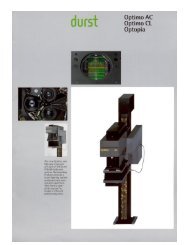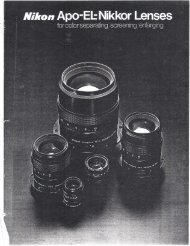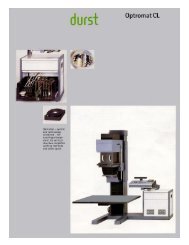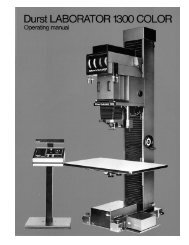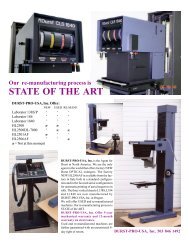At world images inc - durst-pro-usa
At world images inc - durst-pro-usa
At world images inc - durst-pro-usa
Create successful ePaper yourself
Turn your PDF publications into a flip-book with our unique Google optimized e-Paper software.
WELCOME.<br />
DURST-PRO-USA INC. specialize in supporting the CLASSIC PHOTOGRAPHIC ART<br />
COMMUNITY, photo-schools, workshops, discriminating Fine Art Photographers and<br />
Fine Art Printers demanding extreme print quality, high efficiency and quality of life in<br />
their darkroom.<br />
DURST-PRO-USA supply NEW, re-manufactured* and custom build enlargers for 5x7”,<br />
8x10” (10x10”), 11x14” and 12x16” for printing in both BW and Color.<br />
Through our mother company DURST-PRO-USA INC.. – PORTLAND we serve some<br />
of the finest commercial labs in the country with good old fashioned customer centered<br />
service, and machinery of <strong>world</strong> standard.<br />
IMAGINE!<br />
DURST-PRO-USA, INC.<br />
1600 NE 25 T H AVENUE<br />
HILLSBORO, OR 97124<br />
503 846 1492<br />
www. <strong>durst</strong>-<strong>pro</strong>-<strong>usa</strong>. com<br />
EXCLUSIVE AGENT FOR LARGE FORMAT OPTICAL ENLARGERS<br />
1
CONTENTS:<br />
DURST-PRO-USA - different types of enlargers.<br />
QUALITY OF LIFE – PROFIT ON YOUR ART.<br />
SERVICE AND SUPPORT.<br />
EQUIPMENT LEASING.<br />
RE-MANUFACTURING PROCESS.<br />
A NOTE ON PRINTING BW WITH A COLOR DICHRO HEAD.<br />
WHAT IS CLOSED LOOP AND SEMI CLOSED LOOP LIGHT SYSTEMS?.<br />
A NOTE ON QUALITY OF LIGHT.<br />
WHAT IS COLLIMATED LIGHT? (AVAILABLE SEPARATELY)<br />
WHAT IS A CONDENSER HEAD ? – A PAPER ABOUT THE USE OF<br />
CONDENSERS IN PRINTING. (INCLUDED IN ABOVE)<br />
A PAPER ABOUT LENSES AND THEIR USE. (TO FOLLOW)<br />
A STUDY OF DIFFERENT MANUFACTURES LIGHT HEADS, THEIR<br />
OUTPUT AND EVENNESS: (TO FOLLOW)<br />
A STUDY OF ACRYLIC DIFFUSERS AND THEIR EFFECT ON LIGHT: (TO<br />
FOLLOW)<br />
A NOTE ON BUYING USED ENLARGERS<br />
SAMPLE PACKAGES 8X10” -10x10”<br />
SAMPLE PACKAGES 5x7”<br />
ACCESSORIES<br />
SHIPPING.<br />
2
DURST-PRO-USA offer several different types of<br />
enlargers;<br />
1) ENLARGERS FOR PRINTING FORMATS UP TO 5X7” IN BW AND COLOR.<br />
A. DURST 138S<br />
B. DURST 139G<br />
C. DURST 183S<br />
D. DURST 1300<br />
2) ENLARGERS FOR PRINTING FORMATS UP TO 10x10” IN BW AND COLOR.<br />
We have a host of possibilities in 8x10” and 10x10”. They are difficult to group<br />
in a logic manner because of the many possible combinations of chassis, heads,<br />
accessories, functions and formats.<br />
This is a rough grouping:<br />
A. MANUAL VERTICAL CHASSIS<br />
DURST L184, NEW AND RE-MANUFACTURED.<br />
B. MOTORIZED VERTICAL CHASSIS (Incl. Auto focus and Auto size.)<br />
DURST L1840, RE-MANUFACTURED<br />
DURST L1800, RE-MANUFACTURED<br />
DURST L2300, NEW AND REMANUFACTURED<br />
DURST L2400, REMANUFACTURED<br />
HK2000<br />
OTHER BRANDS – USED AND RE-MANUFACTURED<br />
C. MOTORIZED HORIZONTAL CHASSIS, ( Incl. Auto focus / Auto Size)<br />
DURST L2500, RE-MANUFACTURED<br />
DURST L2501 , USED AND RE-MANUFACTURED<br />
DURST L2506, NEW, USED AND RE-MANUFACTURED.<br />
Common for the groups 1 and 2 are that all models share most accessories, negative<br />
holders, lens boards and color heads.<br />
PLEASE REQUEST OUR ENLARGER SELECTION GUIDE FOR A MORE<br />
DETAILED DESCRIPTION OF POSSIBILITIES.<br />
3) ENLARGERS FOR ENLARGING 11x14” , 12x16” AND 20X24” NEGATIVES<br />
AND TRANSPARENCIES IN BW AND COLOR<br />
We have a limited number possibilities, both HORIZONTAL and VERTICAL in<br />
these two formats. These units are most often custom built on request. Please<br />
request special information.<br />
ALTHOUGH OUR RE-MANUFACTURED EQUIPMENT LOOK AND WORK<br />
LIKE NEW, IT IS BASED ON USED MACHINES. PRICES AND<br />
AVAILABILITY THEREFORE TEND TO CHANGE – PLEASE REQUEST A<br />
PERSONALIZED QUOTE – WE WANT YOUR BUSINESS AND STRIVE TO<br />
STAY COMPETITIVE.<br />
3
QUALITY OF LIFE – PROFIT ON YOUR ART.<br />
Whether you are a commercial lab or a fine Art Photographer YOU know that YOUR<br />
time is too valuable to waste on technical issues. Your time is too valuable not to be able<br />
to concentrate on the creative <strong>pro</strong>cess of printing.<br />
Many photographers struggle with old and obsolete equipment. With sheer “mind power”<br />
and concentration they manage to <strong>pro</strong>duce wonderful prints by overcoming the<br />
restrictions of their equipment.<br />
IMAGINE what YOU could obtain by being able to concentrate solely on your IMAGE.<br />
IMAGINE what it would free of artistic energy if you were able to <strong>pro</strong>duce just two<br />
more prints per print session. And then think “Twice as many” and see what that will do<br />
to your daily work, and the quality of your life.<br />
IMAGINE how much further you could get in a year by using the right tool !.<br />
When you buy an enlarger from DURST-PRO-USA Inc.. / DURST-PRO-USA it is<br />
delivered assembled and adjusted with a 5-year WARRANTY - ready for use – just lift<br />
it in to your darkroom and start printing. There will be no need for expensive hidden<br />
repairs and no need to scavenge for weeks for missing parts.<br />
And it is efficient; it delivers even light, fast exposure times, easy operation and precise<br />
focus and alignment. (Alignment is a largely overseen issue, see a discussion under<br />
lenses later in this paper.)<br />
We at DURST-PRO-USA will be no further away than the nearest phone – ready to<br />
answer your technical questions – free of charge as long as you desire before AND after<br />
the sale.<br />
Our 10 steps to Lasting Satisfaction :<br />
1. Lifetime warranty on chassis<br />
2. 5-year warranty on Color Dichro heads and accessories.<br />
3. 8 days of unrestricted right of return<br />
4. We guarantee - Our machines look and function like new<br />
5. We guarantee - No repairs necessary, all mechanical functions are brought to factory standard and<br />
adjusted.<br />
6. We guarantee the possibility to align all stages on the enlarger.<br />
7. We guarantee that no parts will be missing.<br />
8. We guarantee - No cleaning necessary<br />
9. Delivered well packaged and ready to use in plywood crate.<br />
10. FREE telephone support before and after the sale (some restrictions apply.)<br />
All our equipment is MINT or better. It will look and function like NEW.<br />
4
SERVICE AND SUPPORT<br />
We are PROUD to announce that we now have a Durst trained and authorized<br />
technician on staff. Mr. Svenson has more than 20 years experience with Durst, HK and<br />
Devere enlargers. He has installed more Durst enlargers than any other independent<br />
technician.<br />
We are committed to optical equipment and plan on make that our business for the next<br />
generation – if you want us to!.<br />
Whether you are a <strong>pro</strong>fessional lab or a fine Art Photographer we know that you will<br />
appreciate our service because your time is too valuable to fiddle around with technical<br />
issues. You need to concentrate on YOUR ART or <strong>pro</strong>duction.<br />
If you want to get the maximum out of your equipment you need to maintain it – that is<br />
true whether it is your car or your enlarger.<br />
A well maintained enlarger works faster than any digital printer and it is capable of<br />
<strong>pro</strong>ducing higher quality – if you use it right.<br />
Ask us for advice – we are here for you.<br />
CALL US at work<br />
Technical Manager S.Svensson 503 846 9861<br />
Sales Manager Jens J. Jensen 503 846 1492<br />
We are available from 7am to 7pm – 7 days a week. Call us when you need us – don’t<br />
worry - we know you work at night and in the weekends – be happy – we are if you call<br />
US.<br />
DURST-PRO-USA is AGENT FOR DURST<br />
LARGE FORMAT OPTICAL ENLARGERS<br />
FOR NORTH AMERICA.<br />
We service and supply all formats 5x7” and larger.<br />
5
EQUIPMENT LEASING<br />
We offer 24, 36, 48 or 60 month leasing on all equipment.<br />
Consider lease financing for your next equipment acquisition. Rates are often competitive<br />
with bank loans and have added tax write-off advantages.<br />
Terms range from 2 to 5 years and can be tailored to your cash flow.<br />
Our leasing partner is a local family owned company. Mr. Becket and his wife are very<br />
kind and gentle people, not pushy at all and most importantly – they can be trusted. They<br />
both feet on the ground and are willing to work with you until you find a solution that suit<br />
you needs.<br />
GET PRE-APPROVED. Call Allied Pacific leasing and get pre-ap<strong>pro</strong>ved for the<br />
amount you want to spend – even BEFORE you decide on the actual equipment. When<br />
pre-ap<strong>pro</strong>ved you are able to shop with peace of mind and to negotiate the right price<br />
with us.<br />
Multiply the dollar amount you want to invest in the equipment by 0.02697 and you will<br />
have a fairly accurate monthly leasing rate for a period of 48months. Or Visit the Allied<br />
website for additional information and downloadable forms.<br />
Quotations are always available at no-cost or obligation.<br />
After the leasing period is finished the equipment can be purchased to own for one dollar.<br />
CALL – ALLIED PACIFIC LEASING TODAY – (toll-free) 1 888 745 9481.<br />
EMAIL – ALLIED PACIFIC LEASING – ken@alliedpacific.net.<br />
www.alliedpacific.net<br />
6
RE-MANUFACTURING PROCESS.<br />
Our re-manufacturing <strong>pro</strong>cess is the best in the business.<br />
When we re-manufacture an enlarger or a <strong>pro</strong>cessor we cut right to the bone. And we are<br />
not timid about it.<br />
We take the machine completely apart. We clean and sandblast every single piece. We<br />
powder coat and re-assemble with all new parts where necessary. Re-assembly is done<br />
by expert technicians, who know the machines in and out. Finally they are adjusted to<br />
factory tolerances. There are more than 200 man-hours in an enlarger.<br />
All moving parts are replaced, wheels, gears ball bearings etc. are all replaced with new.<br />
New bellows are a matter of course. Chromed parts are polished and re-chromed. All<br />
pumps are replaced. Electronics are replaced with the latest state of the art electronics.<br />
Chromed parts before<br />
stripping, polishing and rechroming.<br />
Enlarger camera<br />
Parts.<br />
Durst L184 bases<br />
Ready for powder<br />
Coating.<br />
A load is<br />
leaving<br />
for<br />
powder<br />
coating<br />
7
Finished enlargers:<br />
THE MOST ADVANCED<br />
CONDENSER SYSTEM<br />
DURST L139G w/CLS300<br />
DURST 2400 W/ DIGITAL LIGHT 2000<br />
DeVERE CHASSIS w/ DL7000 SUPRA and DURST LENS SYSTEM<br />
8
A note on printing BW with a Color Dichro Head:<br />
Even if you are printing strictly BW you may consider using a Color Dichro head. When<br />
printing on Variable Contrast papers a Color Dichro head can be a great advantage due to<br />
the availability of step-less adjustable filtration.<br />
Kodak, Ilford, Agfa, Seagull and others have issued tables that directly translates<br />
Magenta and Yellow filtration combinations into their VC paper grades.<br />
If you use a paper-brand with no published filter combination chart you can use the<br />
Ilford charts as a starting point for establishing your own chart.<br />
SOURCE: ILFORD.COM<br />
With the automatic CLOSED LOOP DIGITAL LIGHT Color Dichro heads the tables are<br />
not necessary. DIGITAL LIGHT Color Dichro heads has Pre-<strong>pro</strong>grammed BW Variable<br />
Contrast grade settings built into the electronics. You can choose any VC setting,<br />
between grade 0 and grade 5 in <strong>inc</strong>rements of 0.1grade.<br />
Using a Color Dichro head for BW can in many cases be a great benefit.<br />
<br />
Using a Color Dichro head allow you to change filtration in mid exposure without any mechanical<br />
<strong>pro</strong>blems, such as opening filter trays, light head doors etc. Unwanted mechanical movement can<br />
thus be avoided.<br />
Even a manual Color Dichro head allow you to chose your VC filter grades in <strong>inc</strong>rements of 0.1,<br />
that is you can choose grade 3,5 or 3,6 or 3,7 and so on IF you establish your own chart.<br />
<br />
<br />
<br />
If you occasionally have a very hard negative that would require a cold light source – then it is<br />
possible to dial inn the cold light equivalent setting and you are ready to print.<br />
Most Color Dichro heads have more light, and a more even light, than any existing Cold light or<br />
Collimated light systems.<br />
A Closed Loop Color Dichro head or SEMI closed loop will automatically calculate the difference<br />
in light output associated with the different filter grades – this makes “split filtration” very easy to<br />
manage.<br />
9
What is Closed Loop and SEMI Closed loop light<br />
systems?<br />
CLOSED LOOP is an advanced color (light) metering <strong>pro</strong>cess. The electronics<br />
controlling a Closed Loop Light Head record the actual color of the light in the mixing<br />
box. It automatically maintain the requested light level and color by compensating for<br />
any fluctuations in line power, lamp, filters etc. Compensation is obtained by adjusting<br />
filter position and voltage feed to the lamp(s) in the Light-head. A Closed Loop Light<br />
head also compensate for all changes DURING an actual exposure. What does this mean<br />
in practice? 1) It enables the operator to accurate repeat a given filter pack. Let us assume<br />
that you printed a negative last week with a “filter pack” of 20M and 70Y at an exposure<br />
time of 10 sec. When you want to print the same negative again, a week later, a month<br />
later or a year later and therefore you ask for that particular “filter pack” (you may even<br />
have it stored in a print channel) you are guaranteed that the paper will receive the exact<br />
same amount of light with the exact same Colour quality as it did last time you asked for<br />
that particular “filter pack”<br />
Also, if you print large series of prints at one time you are always guaranteed that each<br />
print receives the exact same exposure each time you push the expose button.<br />
With a manual head, where you set the filtration on mechanical dials, you very rarely are<br />
able to set the dials precisely the same from time to time, and even if you are able to<br />
repeat a given setting the quality/quantity of light may still differ due to the lamp getting<br />
older, variations in power etc.<br />
Closed loop heads are keyboard controlled. They do not have mechanical dials. Instead of<br />
the operator physically operating a mechanical dial, motors react to keyboard<br />
instructions.<br />
A DIGITAL LIGHT heads react to changes within 1/1000 of a second. Durst and<br />
DIGITAL LIGHT CLOSED LOOP heads have a minimum accuracy of +/- 0.1 f-stop in<br />
Density and of +/- 1 CC color.<br />
CLOSED LOOP has a host of <strong>pro</strong>grammable channels, making it possible to store not<br />
only paper values but also individual print information. Closed loop light heads<br />
<strong>inc</strong>orporate built-in digital timers.<br />
In short – a CLOSED LOOP system reports the actual color (filter value) of the light in<br />
use and maintain it at all times, when lamps are on, with motor controlled filters and<br />
electronically controlled power supply.<br />
SEMI CLOSED LOOP is in all counts the same as described above. The difference<br />
between CLOSED LOOP and SEMI CLOSED LOOP; On a SEMI Closed loop system<br />
the operator has to dial in the desired filtration on a set of mechanical dials. The computer<br />
(Electronic measuring sensor) measures the exact quality of the light in use and report the<br />
measured result on a screen. The SEMI CLOSED system will NOT automatically<br />
maintain a certain filter setting – HOWEVER – it will display the ACTUAL color of the<br />
light and as such make a given setting repeatable with a tolerance of +/- 1 CC. Some<br />
10
systems will alert you with sound warning if the measured light drifts outside preset<br />
tolerances.<br />
You can not store print data in a SEMI CLOSED LOOP System and the timers are not<br />
<strong>inc</strong>orporated into the electronics.<br />
A MANUAL DICHRO HEAD indicate the amount of filtration via a mechanical scale.<br />
There are no correction for fluctuations in power supply, no correction for change in<br />
lamp temperature or any other arbitrary. A manual head does NOT show the actual color<br />
of the light in use. The scale on a manual head indicates a mechanical position of the<br />
color filter in relation to the lamp.<br />
A manual Color Dichro head is in most cases more than enough for BW printing as<br />
hobby or for small print series, and for small printing needs in color.<br />
For the demanding Fine Art Printer who <strong>pro</strong>duces large series it is rarely efficient<br />
enough.<br />
NEUTRAL DENSITY:<br />
30CC NEUTRAL DENSITY IS EQUAL TO 1-fstop LIGHT.<br />
15CC NEUTRAL DENSITY IS EQUAL TO 1/2-fstop LIGHT.<br />
10CC NEUTRAL DENSITY IS EQUAL TO 1/3-fstop LIGHT.<br />
Voltage controlled<br />
TUNGSTEN-<br />
HALOGEN LAMP<br />
11
A note on quality of light:<br />
The light traveling through the negative or transparency in an enlarger, and thus via a lens<br />
forming an image, can be delivered to the photographic emulsion (paper) in many<br />
different “forms”.<br />
The term “forms” embraces such subjects as the directional quality, the spectral<br />
<strong>pro</strong>perties and the amount of light.<br />
In order to enable our selves to understand how light works, in photography and<br />
especially in enlarging, we have to break down the information we have about “light”,<br />
into small bits.<br />
Light is a visible electromagnetic ray with a<br />
certain wavelength, λ, and frequency, V. The<br />
relation between frequency and wavelength is<br />
expressed mathematically as C=λ • V, where<br />
“C” is the light speed (in a vacuum it is 2,998<br />
• 10 8 m/sec)<br />
Radiation in the visible spectrum is expressed<br />
in “nm” (nanometer= 10 -9 meters)<br />
Of all the wavelengths the human eye can<br />
only perceive a narrow band (spectrum) from<br />
380nm to 780nm. The eye is most sensitive in<br />
the middle of the spectrum, sensitivity peaks<br />
around 500nm.<br />
For wavelengths immediately over and under the human perception we use the terms<br />
infrared (IR) and ultraviolet (UV) radiation.<br />
High values of Colour temperature – over 3000K – belong to the blue end of the<br />
spectrum and low values belong to the red end of the spectrum. We normally associate<br />
the colour blue with “cold”. Oddly enough when talking about light “blue” is warmer<br />
(hotter) than the red light – “Red” being the colour we normally associate with warm.<br />
In the same manner as a human being photographic materials are able to perceive<br />
different spectrums of light. And they may also have peaks inside the spectrum they are<br />
able to perceive.<br />
Films, BW papers, Type C Color papers and Ilfocrome papers are all sensitive to visible<br />
light. The specific sensitivity differs from material to material. Some materials are more<br />
sensitive to one color than to another which would be the same as saying that; their<br />
sensitivity peak at different places within the spectrum they are sensitive to. This is how<br />
the manufacturer controls the physical <strong>pro</strong>perties of their paper, contrast, color etc.<br />
In addition to being sensitive to visible light most materials are also sensitive to UV and<br />
IR radiation. The specific sensitivity to these wavelengths differ from material to<br />
12
material. Because the are sensitive to the same spectrum as the human eye they must be<br />
handled in total darkness, or under safelight designed for the material in question.<br />
Most color papers are fairly sensitive to UV and manufactures of advanced Color heads<br />
use heat filters that restrict both UV and IR light waves in reaching the paper during<br />
exposure. IR radiation is also known as “heat rays”.<br />
The sensitivity curve on the right is an<br />
example of Kodak of Type C paper<br />
sensitivity. From this example it is obvious<br />
that this particular paper is sensitive in the<br />
visible spectrum, it is sensitive from 390nm to<br />
750nm. It is also clear that it is not equally<br />
sensitive throughout the spectrum, it is more<br />
sensitive to blue light than to red light.<br />
The sensitivity curves below are for Ilford<br />
MULTI GRADE fiber-base paper and for<br />
ILFOCHROME (CIBACHROME) paper .<br />
IMAGINE the spectral sensitivity curves for a<br />
photographic paper super imposed on top of<br />
one of the spectral emission curves for lamps,<br />
shown below, and you will start to understand<br />
why certain lamp types does not work with<br />
certain papers (photographic emulsions) and<br />
also why certain types of safelight does not<br />
harm certain papers.<br />
Our eyes and photographic emulsions are<br />
sensitive to different spectrums of light.<br />
Lamps of different kinds emit energy (light)<br />
with different spectrums. Some lamps have<br />
peaks in their spectrum.<br />
Daylight and <strong>inc</strong>andescent lamps and<br />
tungsten-halogen lamps emit a continuous<br />
spectrum – the spectral efficiency curve is<br />
unbroken = without peaks. Both <strong>inc</strong>andescent<br />
lamps and tungsten-halogen lamps <strong>pro</strong>duce<br />
the major part of their radiation (emission) in<br />
the “red” (IR) end of the spectrum. As a<br />
matter of fact only 8-9% of the total energy<br />
used by a tungsten-halogen lamp is<br />
transformed into visible light. More than 80%<br />
is turned into heat (IR) and the rest is either<br />
lost in the <strong>pro</strong>cess or emitted as UV. UV<br />
emission from an <strong>inc</strong>andescent or tungstenhalogen<br />
lamp is normally below 2%.<br />
Spectral sensitivity curve for<br />
Ilford VC Fiberbase paper<br />
Spectral sensitivity curve for<br />
Ilford ILFOCROME<br />
13
This explains in particular the necessity for<br />
heat filters but also for UV filters in enlarger<br />
heads.<br />
Tungsten-Halogen spectral emission curve.<br />
Fluorescent lamps and metal-halogen lamps<br />
have broken sensitivity curves – that is; they<br />
emit some light in the entire visible spectrum<br />
but the major of their emission are in narrow<br />
bands. See examples on your right.<br />
By examining the emission curves for<br />
fluorescent lamps and the spectral sensitivity<br />
curve for the Ilford Fiber base paper- above –<br />
you will find an explanation as to why some<br />
printers have run into <strong>pro</strong>blems with their<br />
“cold-light heads” when using BW-VC paper.<br />
Maybe you have tried to photograph on color<br />
film under fluorescent “daylight” type lamps<br />
and have been surprised to find your<br />
transparencies with a strong cyan/green color<br />
cast. This is caused by the fluorescent lamps<br />
having a spectral emission different from what<br />
is understood by the film as “daylight”. Which<br />
essentially is the exact same <strong>pro</strong>blem printers<br />
run into with certain types of “coldlight<br />
heads”.<br />
The spectral sensitivity for ILFORD Fiber<br />
Base paper is very high even below the visible<br />
spectrum (380nm) and maintain that<br />
sensitivity up to 525nm where it drops of<br />
drastically and basically it is not sensitive at<br />
all above 550nm. If the neon tube in a given<br />
coldlight head had the same spectral<br />
sensitivity curve as our tube “B” it would be<br />
almost impossible to get an exposure on the<br />
paper because tube “B” peaks above right at<br />
and above 550nm. And has very little<br />
emission, apart from UV, in the spectrum<br />
where the paper is sensitive.<br />
As a matter of fact all three tubes would be<br />
poor for Ilfords paper which is obviously<br />
designed for Tungsten or Tungsten-Halogen<br />
light.<br />
Of the three fluorescent lamps “B” would be<br />
the tube best suited for platinum printing and<br />
A.<br />
B<br />
C.<br />
METAL HALOGEN LAMPS use Ne (Neon) inert<br />
gas which is the same gas as used in neon tubes.<br />
3000K 4500K 5500K<br />
SPECTRAL EMISSION CURVES FOR<br />
FLUORESCENT TUBES / NEON TUBES.<br />
Although all three will look the same to the eye they<br />
certainly differ in emission.<br />
3200K 4000K 2700K<br />
14
other UV printing due to the very high<br />
emission in the UV area.<br />
As you will see from the spectral emission<br />
curve for a Phillips safelight lamp it’s<br />
emission has been modified to cover an area<br />
above 600nm. An the emission in the 600nm<br />
area is at its lowest with most emission in the<br />
area around 700nm where (Ilford)<br />
photographic paper is least sensitive and the<br />
human eye still able to perceive the emission.<br />
The color of light is expressed as “The color<br />
temperature” and it is measured in Kelvin (K).<br />
Degree Kelvin is an absolute temperature<br />
scale contrary to Degree Celsius. T K = T C +<br />
273.<br />
Emission curve for Phillips darkroom lamp<br />
PF710 and PF712.<br />
Chromaticity<br />
diagram to<br />
DIN5033<br />
The colour of light = colour temperature can<br />
be described very precisely with a set of<br />
coordinates (X,Y), in a diagram called a<br />
“Chromaticity diagram”. This diagram is<br />
internationally recognized and is becoming<br />
more popular in photography and re<strong>pro</strong>photography,<br />
scanning etc. as a universal<br />
standard.<br />
It is important to understand that two light sources can have the same colour temperature<br />
but at the same time completely different spectral effect distribution. This is obvious<br />
when comparing the spectral emission curves for Fluorescent lamp, with a colour<br />
temperature of 3200K, to a Halogen lamp with the same colour temperature.<br />
Like sound waves, light waves can be manipulated, modified and transformed into forms<br />
needed for a given purpose, in this case printing with an enlarger.<br />
We can mix light. The light beam from two light sources – two bulbs - each with<br />
different spectral emission characteristics can be mixed to form a third “light source”<br />
with a spectral emission curve different from the two “source” lamps.<br />
We can also modify a light source by filtering. IMAGINE a sheet of green fabric as a<br />
crude filter. If this “filter” is inserted into a beam of light, the light on the “beam side” of<br />
the fabric will have different characteristics (colour) than the light that penetrated the<br />
fabric/filter.<br />
One thing we cannot do – we cannot ad to a light source where nothing exists to be<br />
added. We cannot ad a dye, if we want to obtain light in a colour different from that of a<br />
given light source. No such dye exists for practical use. (Light experts will argue that the<br />
15
light emitted from neon tubes are dependent on powder (dye) that can be mixed to create<br />
different spectral emission curves for a given tube.)<br />
The only way we can change the “colour” of an existing light source, by adding to this<br />
given light source, would be to add emission from a lamp emitting the spectrum/colour<br />
that we would be trying to obtain. And even then we would still end up with a “colour”<br />
different from the “colour” of both our “source” lamps because our new light source<br />
would be a mix of the two source lamps. To predict a certain outcome from combining<br />
two light sources would be a very time consuming and highly theoretical calculation.<br />
The only practical way to change the colour of an existing light source, in a predictable<br />
manner, is to manipulate the light with a filter. A “filter” is whatever will give you the<br />
result that you are trying to obtain. It can be anything from a coloured fabric, to a very<br />
advanced piece of glass with <strong>pro</strong>perties that can alter the light in question.<br />
Most light sources are considered “white-light-sources”. A “white-light” light source is a<br />
light source emitting a spectrum (mixture of) light that the eye perceive as balanced –<br />
neutral. White light consists of a mixture of red, green and blue light waves. We have to<br />
remove a section of the total spectrum in order to create the colour-spectrum we want, if<br />
only one light source is available for the purpose.<br />
If we manipulate our light beam by introducing Red, Green and Blue cut-off filters in the<br />
light beam we would be using the so called Additive filter System.<br />
If we remove the yellow portion of a “white light” beam, by introducing a blue additive<br />
filter in the light beam, the resulting colour left would be Blue = Magenta + Cyan.<br />
If we remove the magenta portion of the “white light”, by introducing a Green additive<br />
cut-off filter in the light beam we are left with Green = Yellow + Cyan.<br />
If we remove the Cyan portion of the “white light”, by introducing a Red additive cut-off<br />
filter in the light beam, we are left with Red = Magenta + Yellow.<br />
If we stack a Red, a Green and a Blue additive cut-off filter on top of each other we<br />
would in theory block out all light. (In reality some light still leaks through.)<br />
Red<br />
Yellow.<br />
Magenta<br />
Green.<br />
The complementary<br />
(opposite) colour to Red<br />
would be Cyan, the<br />
complementary colour to<br />
Blue would be Yellow and the<br />
complementary colour to<br />
Green would be Magenta.<br />
Blue.<br />
Cyan.<br />
16
If we manipulate a light beam by introducing Cyan, Magenta or Yellow cut-off filters in<br />
the light beam we would be using the Subtractive filter System.<br />
If we remove the Red portion of a “white light” beam, by introducing a Cyan Dichroic<br />
Filter in the light beam, the resulting colour left would be Cyan = Green + Blue. .<br />
If we remove the Green portion of the “white light”, by introducing a Magenta Dichroic<br />
Filter in the light beam, we are left with Magenta = Red + Blue.<br />
If we remove the Blue portion of the “white light”, by introducing a Yellow Dichroic<br />
Filter in the light beam, we are left with Yellow = Red + Green.<br />
Contrary to common belief we also block out light if we stack a Cyan, a Magenta and a<br />
Yellow cut-off filter on top of each other. If we introduce equal amounts of Cyan,<br />
Magenta and Yellow we block off light in an amount equal to the numerical value of one<br />
of the three colours. Ex. If we introduce 30cc Cyan, 30cc Magenta and 30cc Yellow into<br />
a light beam we will block out 50% of the available light, because 30cc of each of the<br />
three colours together make up 30cc ND – which in photographic terms are equal to one<br />
f-stop.<br />
NEUTRAL DENSITY:<br />
60cc NEUTRAL DENSITY IS EQUAL TO 2-fstop’ LIGHT.<br />
30cc NEUTRAL DENSITY IS EQUAL TO 1-fstop LIGHT.<br />
15cc NEUTRAL DENSITY IS EQUAL TO 1/2-fstop LIGHT.<br />
10cc NEUTRAL DENSITY IS EQUAL TO 1/3-fstop LIGHT.<br />
All of the above basic knowledge for all colour printers.<br />
After having been through the study of Spectral sensitivity Curves and lamp spectral<br />
emission curves we will immediately understand the transmission curves on the next<br />
page.<br />
Those are the actual transmission curves for the three Subtractive filters (Cyan,<br />
Magenta and Yellow) from a DURST- DIGITAL LIGHT Colour Dichro head.<br />
Take a look at the curve for the Cyan filter. It blocks light above 620nm, which is the red<br />
spectrum and thus it creates a Cyan light source.<br />
The Magenta and Yellow cut-off Dichroic filters work in the same manner. The Magenta<br />
Dichro filter blocks the spectrum from ap<strong>pro</strong>x. 400nm to ap<strong>pro</strong>x 620nm. And in that<br />
manner it creates a Magenta “light source” by transmitting the red and the blue portion of<br />
the spectrum. The Yellow Dichro filter blocks everything below 520nm which is the blue<br />
end of the spectrum and creates a Yellow light source.<br />
17
Just as we could remove one of the three primary colours, Red, Green and Blue we could<br />
also have removed one of the three secondary colours, Cyan, Magenta and Yellow by us<br />
inserting a combination of two of the subtractive filters simultaneously. If we insert equal<br />
amounts of Magenta and Yellow Dichro filters into a light beam we will create a red light<br />
because we block out everything above the red spectrum.<br />
Cyan Colour Dichro<br />
filter from<br />
DIGITAL LIGHT<br />
A more detailed study of the spectral <strong>pro</strong>perties of Dichro Filters show that, by using a<br />
“Color Dichro Head”, with a set of Subtractive filters, we are in fact able to create a light<br />
source with a characteristics that will suit almost any photographic emulsion. Due to the<br />
low UV emission a Modern Color Dichro Light-head is obviously not well suited for<br />
those emulsions sensitive mainly to UV radiation.<br />
It can also be argued that a “Color Dichro Head” is not able to imitate a neon tube<br />
(“Cold-light-head”). That is of course true when talking about the high UV radiation<br />
emitted by most neon tubes, but it is in fact possible to create a “filterpack”, with a Color<br />
Dichro head, that will create a light source with an emissions VERY similar to the<br />
emission of the type of neon tubes / fluorescent tubes used in so called “Cold-lightheads”.<br />
18
Magenta Colour<br />
Dichro filter<br />
from<br />
Yellow Colour Dichro<br />
filter from<br />
DIGITAL LIGHT<br />
19
After having examined the physical <strong>pro</strong>perties of light – colour and spectral emission –<br />
we can finalize this study by examining the quantitive <strong>pro</strong>perties of light.<br />
Most people naturally understand that we can concentrate and focus light in a beam – and<br />
they use it daily without thinking about it, placing a lamp shade on a regular household<br />
lamp is in fact a manipulation of light rays. The light ray emitted from the lamp bulb is<br />
concentrated, diffused and filtered all at once by placing a lampshade over it.<br />
Concentrating a light source can be very power full. Just think of the experiment we all<br />
made in school with a magnifying glass, the sun and a piece of paper.<br />
We can also bend light rays. With a mirror we can make light rays bend around a corner.<br />
When you see your self in the mirror it is in fact <strong>pro</strong>of that light rays can bend by using a<br />
shiny (reflective – mirror) surface. The light rays reflected off you face hits the mirror<br />
and is reflected back to your eyes.<br />
Both concentration and reflection is used heavily in modern light sources for enlargers.<br />
The light is bounced off mirrors and reflectors with different <strong>pro</strong>perties creating a light<br />
source that is either concentrated or spread out. How this works exactly is explained in<br />
detail in a chapter under DURST & DIGITAL LIGHT Color Dichro Heads.<br />
One little detail needs to be discussed here. If you have ever worked with artificial light<br />
in a studio situation, you know that the brightness / intensity of a lamp drops drastically<br />
when the distance from the light source to the object is <strong>inc</strong>reased. As a matter of fact if<br />
the distance is doubled the intensity is reduced to 25% of the value it was at the closer<br />
distance.<br />
With other words – if you measure f45 on an object lit by a lamp standing one foot away<br />
from the object you would measure only f32 if the lamp was placed 2 feet away.<br />
If the lamp was placed 8 feet from the subject you would read only f8 equal to 3%, - the<br />
light would be reduced with 5 f-stops.<br />
We pointed a lamp into a “mixing box” 12 <strong>inc</strong>hes (1 foot) deep, and read f45 off a piece<br />
of white acrylic that we had placed in the opposing end of the mixing box. A mixing box<br />
is a box lined with a reflective surface, or in this case a mirror, and having a piece of<br />
white acrylic (type 0.6) covering two opposing sides (ends). We the repeated the<br />
experiment with a mixing box 8 feet long. This time the lightmeter read f32 2/3 . This is<br />
a reduction of only 1/3 f-stop.<br />
This is information is based upon a practical experiment made in our test-lab.<br />
1 foot (12”) 8 feet<br />
100% 100%<br />
White acrylic, light measurement f45.<br />
Lamp directed into box lined with mirrors. White acrylic, f32 2/3<br />
20
Our experiment <strong>pro</strong>ved that we can in fact direct, concentrate, bend and manipulate light<br />
rays.<br />
In addition to concentrating light with the use of mirrors and reflective surfaces we can<br />
also concentrate or spread light with the use of a lens.<br />
Finally we can “break” the light. By introducing either a physical obstruction or a “Multireflective”<br />
(broken) surface we can break a heavily concentrated light beam into a<br />
myriad of light-rays. This is called diffusion.<br />
A crude diffuser could be a very fine mesh of either cloth, plastic or metal. Imagine the<br />
sun shining through the screen door.<br />
We can also diffuse the light with a lens. If we shine a light beam through a magnifying<br />
glass we can move the magnifying glass forth and back and manually focus the light in a<br />
very concentrated beam. But we can also diffuse the light by intentionally moving the<br />
magnifying glass to an “out of focus position”. We can bring the light beam so far out of<br />
focus that the light beam will be reduced to a large circle of flare.<br />
We can further <strong>inc</strong>rease diffusion through a lens by making the focal length infinitively<br />
small and by reducing clarity from the glass used in the lens.<br />
A piece of ¼” thick Plexiglas is a “lens” with a very very small focal length. By adding a<br />
“milky white” coloring to the Plexiglas we have in fact created the perfect diffuser for<br />
light.<br />
Finally we can restrict the amount of light emitted from a light source. We can of course<br />
do it mechanically by introducing an aperture, a metal diffuser or metal grid or by<br />
introducing a filter with ND (neutral density) coating.<br />
But we can also do it electronically or electrically by restricting the amount of current<br />
supplied to the lamp. (this particular subject is covered under the digital light subject.)<br />
Light can be manipulated in tho<strong>usa</strong>nds of different ways. Light sources can be<br />
created in tho<strong>usa</strong>nds of different ways.<br />
In photography all “lightheads” belong to one of two groups. They are either categorized<br />
as “SOFTLIGHT HEADS” or as “FOCUSED LIGHT HEADS” (also called Collimated<br />
light-heads)<br />
Most all light heads (Cold-light-heads, VC heads and Color Dichro heads) belong to “Softlight”<br />
group.<br />
To my knowledge only one type light source, for optical photography, belong in the second<br />
group, “Focused Light heads”, and that is the Condenser head. A condenser head can<br />
<strong>pro</strong>duce several different degrees of focused light by varying the lamp <strong>pro</strong>ducing the light<br />
21
eam, the quality of the condensers, the distance between the condenser-elements etc. A<br />
point light lamp will <strong>pro</strong>duce a more focused light than an Opal lamp source. A coated<br />
condenser will <strong>pro</strong>duce a more focused light than an uncoated condenser etc. The different<br />
combinations all deliver light of different degrees of collimation.<br />
Of all the different types of Light-heads for optical photography (enlarging) the condenser<br />
head must rank as the most versatile light head available. This remark is bound to raise<br />
an eye brow here and there and possible a “gasp” in some places.<br />
Let me therefore defend that remark right away.<br />
A condenser head is capable of emulating all other types of light heads available for<br />
enlarging.<br />
It of course delivers collimated light of varying degrees.<br />
It also is capable of <strong>pro</strong>ducing soft light of varying degrees.<br />
It can be used for Color printing as well as for BW printing. The Condenser head may<br />
not be as practical * 1 for Color printing as a Color Dichro Head, but it can do it.<br />
No other light head is capable of delivering all four features.<br />
Not the Color Dichro Head – it cannot <strong>pro</strong>duce Collimated Light.<br />
However, so far, the COLOR DICHRO head must rank as the most advanced light source. It<br />
is capable of emulating all types of light sources in it’s group. And it is capable of doing so in<br />
an efficient and rational manner.<br />
Jens J Jensen, December 2000.<br />
Literature list:<br />
Electric light sources by The Danish Society of Light technique.<br />
Phillips, Holland.<br />
Osram, Germany<br />
Ilford.com<br />
Kodak.com<br />
Andover Corp.<br />
Post Exposure by CTEIN.<br />
Photographic Sensitometry by Todd & Zakia.<br />
*1) In the fall of 2001 DURST-PRO-USA will introduce an automatic Color Dichro Condenser head for<br />
printing BW or Colour with an automatic closed loop Colour Dichro Condenser head.<br />
22
What is Collimated Light?<br />
(to follow)<br />
What is a condenser head ? – a paper about the use of<br />
condensers in printing.<br />
(to follow)<br />
A paper about lenses and their use:<br />
(to follow)<br />
A study of different manufactures light heads, their<br />
output and evenness:<br />
(to follow)<br />
A study of acrylic diffusers and their effect on light:<br />
(to follow)<br />
Storage area in warehouse.<br />
23
A note on buying used enlargers:<br />
IMAGINE your self as someone dependent on a car, for work or pleasure.<br />
Then try to IMAGINE your self in 10-15 year old “clunker”.<br />
That makes no sense – does it?<br />
DURST-PRO-USA INC.. / DURST-PRO-USA does NOT sell used equipment.<br />
This does NOT mean that we are not competitive on prices – rather the opposite. And it<br />
does NOT mean that we do not want your business.<br />
We DO want your business – we are willing to fight for it.<br />
However, based on past experience we have decided not to sell USED or re-furbished<br />
equipment. Our experience tells us that it is not possible to satisfy the average users<br />
expectations to a used enlarger.<br />
To many suppliers has given the word re-furbished a bad name. Today most buyers<br />
understand re-furbished to be equal to “rust with makeup”.<br />
Let us be frank about this issue.<br />
A used enlarger very rarely spent its life in a Fine Art Photographers darkroom. Used<br />
enlargers come from commercial photo-labs. A commercial photo-lab rarely sells a<br />
machine that function well. They use up the machine – that is good business.<br />
Selling a used and worn down enlarger to a photographer or printer with expectations of<br />
being able to use it, without constantly having to “fiddle” with it to make it work, or<br />
simple expectations of having joy without spending tho<strong>usa</strong>nd of dollars additional is<br />
simply not possible and the same time maintain ones self respect.<br />
THAT IS WHY WE DO NOT SELL USED ENLARGERS.<br />
We sell re-manufactured machines in NEW condition at a price level very close to that for used<br />
machines.<br />
In the spring of 2001 we decided to test quality of used machines on the market.<br />
We went out and bought four used 10x10” Durst enlargers in our own names, we did not<br />
ap<strong>pro</strong>ach the seller as DURST-PRO-USA Inc.. or DURST-PRO-USA.<br />
We purchased two Durst L184, one with a CLS1840 manual Color Dichro Head and one<br />
with a condenser head.<br />
We purchased a Durst L183 (Special edition 5x7”) and a Durst L1840 with a CLS1840<br />
Color Dichro head.<br />
24
We purchased from a large brokerage company, from a dealer and from two lab’s, one<br />
just getting rid of one enlarger and one closing down.<br />
Our experience – we would rather have been without it, even for our purpose it was a bad<br />
experience – IMAGINE what it would have been to an end-user with expectations of Joy<br />
and High Quality printing.<br />
Let me tell you about the worst case:<br />
We had to pay 100% up front for both the machine and the freight. We were requested to<br />
sign off on a waiver, giving up all rights to complain, in other word we were requested to<br />
buy “AS IS” UNSEEN – UN-INSPECTED.<br />
The enlarger, a Durst L184 with CLS1840, arrived six weeks after paid and four weeks<br />
after <strong>pro</strong>mised.<br />
We had to call six times to get the thing shipped off, and send 8 e-mails with answers to<br />
questions concerning packing – just to realize that the answers were ignored.<br />
Despite very thorough instructions from us – and <strong>pro</strong>mises of the instructions being<br />
followed the enlarger was packed – no it was shoveled – in wooden boxes with<br />
absolutely no padding of any kind. The negative holder, apart from being broken and<br />
completely useless – was packed in a box with lens holders and electronic boxes<br />
WITHOUT any padding what so ever. Imagine what heavy electronic boxes, with sharp<br />
corners, did to the delicate parts during a truck voyage from the Mid-west to Oregon!!.<br />
The lamp and the reflector in the Color Dichro head has a retail replacement value of<br />
ap<strong>pro</strong>x $850.00 and was <strong>pro</strong>mised removed from the Color Head and packed separately<br />
in secure padding for transport.<br />
This was not done. The reflector is of glass and heavy. It had rattled around inside the<br />
lamp house, was totally disintegrated – taking the bulb with it and the very expensive<br />
heat mirror in front of the lamp.<br />
Had it also ruined the Color Dichro Filters it would not have mattered s<strong>inc</strong>e they had<br />
been overheated and the coating therefore was flaking off.<br />
And, and, and<br />
It took our highly trained technician 5 full working days and parts worth $3,118.00<br />
wholesale to make the enlarger function. This repair did not <strong>inc</strong>lude the useless negative<br />
holder, it was beyond repair, replacement price $1250.00. After spending $4,368.00 and<br />
the purchase price we had an enlarger looking like a wreck and possible needing further<br />
repairs down the road. Our repairs did not <strong>inc</strong>lude any hidden <strong>pro</strong>blems. The total price<br />
ended up being almost the same price as a <strong>durst</strong>-<strong>pro</strong>-<strong>usa</strong> remanufactured enlarger with 5-<br />
year and LIFETIME warranty - with no hidden <strong>pro</strong>blems GUARANTEED.<br />
25
Two of the four purchases were not that bad, and one would have been satisfactory to<br />
most.<br />
We have invoices, photographs, correspondences and freight bills to document our<br />
experiences.<br />
You are welcome to request documentation.<br />
Let us face it – an enlarger in a commercial photolab is not serving as a “mommobile”<br />
it is being used like a NEW-YORK-TAXI-CAB.<br />
Therefore – if you buy used be sure to inspect the machine prior to purchase.<br />
26
SAMPLE PACKAGES<br />
8X10” –10x10”<br />
DURST-PRO-USA INC..<br />
1600 NE 25 T H AVENUE<br />
HILLSBORO, OR 97124<br />
503 846 1492<br />
27
DURST L184, manual enlarger w/ DIGITAL LIGHT<br />
Americana closed loop Color Dichro head.<br />
This is the traditional manual chassis. It is different from the 1800 and 1840. It has two vertical<br />
columns that are exposed and not encapsulated in a casing as with the 1800 and 2400. The head and<br />
baseboard are moved via a hand crank or via optional motors. There is possibility for either a lens<br />
turret accepting lenses up to 240mm or single lens boards. Prints up to 40x50” on baseboard.<br />
We have equipped the Durst 184 with a Brand New Digital Dichro Color head w/ CLOSED<br />
LOOP. The most advanced 10x10” head on the market. See attached text on our NEW Digital<br />
Dichro head.<br />
1 pc Durst Laborator 184 enlarger refurbished/used in new/mint condition complete<br />
with camera and built in 4-way masking<br />
1 pc DIGITAL LIGHT Americana Dichro head, NEW –unused.<br />
1 pc Keyboard, NEW –unused.<br />
1 pc Mixing box adapter LACAP184<br />
1 pc Mixing box LACOBOX100 for 8x10”<br />
1 pc Register negative holder adapter, GRAHALON<br />
1 pc register negative holder GRANE<br />
1 pc Vacuum board 25x33”” , GRAVAPU<br />
1 pc Rodenstock Apo Ronar 360mm/f9<br />
1 pc Schneider Componon 300mm/f5,6<br />
1 pc Rodenstock Apo Ronar 240mm/f9<br />
1 pc Componon 150mm/f5,6<br />
2 pc Lens board VAPLA (for 300 and 360mm)<br />
1 pc Lens board UNIPLA<br />
2 pc Lens adapter for UNIPLA (for 240mm and 150mm)<br />
Price for the above complete package: see enclosed price list.<br />
Vacuum baseboard can be replaced with 30x40” standard baseboard.<br />
28
DURST L184, black and white condenser version<br />
1 pc Durst Laborator 184 enlarger refurbished/used in new/mint condition<br />
complete with camera and built in 4-way masking<br />
1 pc Register holder GRAHALON<br />
1 pc Register negativeholder, GRANE<br />
1 pc GRAGLAS 205, AN<br />
1 pc GRAGLAS 205 regular<br />
1 pc Condenser head<br />
1 pc Filter drawer<br />
1 pc Condenser LAUTICO 181<br />
2 pc Condenser 380<br />
1 pc Baseboard, regular<br />
3 pc Lens board, UNIPLA<br />
1 pc Componon 300mm<br />
1 pc Componon 210mm<br />
Price for the above complete package: see enclosed price list.<br />
AD MOTORIZED OPERATION:<br />
The above package FULLY MOTORIZED version, head, focus and baseboard<br />
Price CALL<br />
The above package with motorized focus ONLY<br />
Price CALL<br />
29
HVA Vertical 10x10” enlarger. Wall mounted,<br />
Motorized head and FOCUS, Semi Closed Loop<br />
LABORATOR HVA250 wall mounted enlarger complete with lenses, ready to use no<br />
parts needs be purchased.<br />
1 pc LABORATOR HVA250 fully motorized chassis with wall brackets.<br />
1 pc Control unit for motorized focus and head position – degree of enlargement.<br />
1 pc Color Dichro head<br />
1 pc Keyboard for controlling Color Head.<br />
1 pc 8x10” mixing box<br />
1 pc Negative holder 10x10”<br />
2 pc Glass for negative holder.<br />
4 pc Lens board<br />
1 pc Rodagon f5,6 – 300mm lens<br />
1 pc Rodagon f5,6 – 150mm lens<br />
Price for the above complete package: see enclosed price list.<br />
30
SAMPLE PACKAGES<br />
5x7”<br />
DURST-PRO-USA INC..<br />
1600 NE 25 T H AVENUE<br />
HILLSBORO, OR 97124<br />
503 846 1492<br />
31
DURST 138S Manual vertical 5x7” enlarger. W/ CLS300 –<br />
2000 watt Color Dichro head.<br />
The 138S has the traditional manual chassis with one column. The head and the baseboard are<br />
moved via spring tension/spring release. Foot pedal for baseboard movement. The baseboard is<br />
25x33”.<br />
Our Durst 138S are all equipped with the manual CLS300 2000watt Dichrohead from Durst.<br />
This is a<br />
Mean machine for printing all formats <strong>inc</strong>luding 5x7” and 2 ¼ x 7”. All our 138S models are<br />
delivered<br />
With a full set of masks <strong>inc</strong>luding the new 2 ¼ x 7” mask (6x17cm).<br />
You can choose between the regular negative holder NEGA138 or<br />
the register holder GRAHALON57.<br />
1 pc Durst 138S chassis complete with camera w/ 4 way adjustable<br />
masking system. Lens turret accepting 3 lenses up to 240mm,<br />
regular baseboard with ball head mount.<br />
1 pc Dichro head CLS300 2000watt.<br />
1 pc Dichro head adapter LACAP138<br />
1 pc Mix box 5x7”<br />
1 pc Power box EST300<br />
1 pc Baseboard<br />
1 pc Exhaust blower<br />
1 pc Negativ holder NEGA138<br />
1 pc Rodenstock Rodagon 210mm<br />
1 pc Rodenstock Rodagon 150mm,<br />
1 pc Rodenstock Rodagon 105mm,<br />
1 pc Lens-turret, accepting lenses up to 240mm but not <strong>inc</strong>luding 240mm.<br />
2 pc TRIPLA lens rings, for 150mm and 105mm<br />
Price for the above complete package: see enclosed price list.<br />
Same enlarger with BW Condenser head CALL<br />
Same enlarger with Aristo VC head is CALL<br />
Same enlarger with CLS1000 Color Dichro head is CALL<br />
Same enlarger with BWL 2000watt Soft light head is CALL<br />
32
DURST 138S Manual vertical 5x7” enlarger . CLS301 Color<br />
Dichro head.<br />
This is the most sold and most traditional solution. Completely manual machine. Complete and ready for<br />
use. No parts needed. Everything is MINT condition.<br />
This is a standard package. It can of course be reduced and or changed/enlarger.<br />
Durst Laborator 138S, see enclosed manual.<br />
Ready for printing both Color and B&W, both graded and variable contrast B&W.<br />
1 pc Durst 138S chassis complete with camera w step-less adjustable masks, completely refurbished<br />
in mint/new condition<br />
1 pc Camera with fixed TRIPLA lens turret<br />
1 pc Dichro head Durst CLS301 600 watt.<br />
1 pc Dichro head adapter LACAP138<br />
1 pc Mix box 5x7”<br />
1 pc Powerbox EST/TRA301<br />
1 pc Negativeholder NEGA138<br />
2 pc 5x7” Glass for negative holder<br />
1 pc Rodenstock Rodagon 210mm,<br />
1 pc Rodenstock Rodagon 105mm,<br />
1 pc Rodenstock Rodagon 50mm,<br />
1 pc UNIPLA lensboard<br />
3 pc TRIPLA lens rings<br />
1 pc Crating<br />
Price for the above complete package: see enclosed price list.<br />
33
DURST 139G Manual vertical 5x7” enlarger . 2000 watt Color<br />
Dichro head and BW Condenser head.<br />
This is our most complete package. It is a “sample package” . It can of course be reduced. We sell this<br />
package mostly to Fine Art photographers who wants to do masks and have a future possibility to step up to<br />
5x7’ if they are not already using this format. Complete and ready for use – no parts needed. We have anly<br />
one complete package left, and can not guarantee a similar complete package in the future.<br />
The CLS300 is our most power full manual head.<br />
1 pc Durst 139G chassis complete with camera w step-less adjustable masks, completely refurbished<br />
in mint/new condition<br />
1 pc Camera with fixed TRIPLA lens turret<br />
1 pc Dichro head Durst CLS300 2000 watt.<br />
1 pc Dichro head adapter LACAP138<br />
1 pc Mix box 5x7”<br />
1 pc Powerbox EST/TRA301<br />
1 pc B/W condenser head<br />
1 pc set for 5x7” printing<br />
1 pc Register negative holder GRAHAL<br />
1 pc Insert for register holder, GRANE 138<br />
1 pc Film register punch 2x2 up to 16x20”<br />
1 pc 5x7” Glass for negative holder<br />
1 pc mask for A, 21/4x3<br />
1 pc mask for A, 21/4x21/4<br />
1 pc mask for A, 4x5”<br />
1 pc mask for 6x4,5cm<br />
1 pc Mask for 24x36<br />
1 pc Durst REPRO lamps with iffuser<br />
1 set Extensions arms for lights<br />
1 pc Register Camera back w/ 5x7” ground<br />
screen<br />
1 pc Film holder 5x7” for camera back<br />
1 pc Schneider Componon 2105,6<br />
1 pc Schneider Componon 5,6 150mm<br />
1 pc Rodenstock R.odagon 80 5,6<br />
1 pc Rodenstock Rodagon 2,8 50mm<br />
5 pc Lensboards for lenses shown<br />
1 pc Crating.<br />
Price for the above complete package: see enclosed price list.<br />
34
DURST Laborator 1300 fully motorized vertical 5x7” enlarger .<br />
1000 watt Color Dichro head.<br />
This is a very unique enlarger. There is less than ten units in the US, we have two used arriving on August<br />
21 – 2000.<br />
1 pc Durst L1300 fully motorized chassis complete with camera w/ step-less adjustable masks,<br />
in mint/new condition<br />
1 pc Proffesional camera accepting the <strong>pro</strong>fessional series lens boards<br />
1 pc Dichro head Durst CLS 1000 – 1000 watt.<br />
1 pc Mix box 5x7”<br />
1 pc Mix box 4x5”<br />
1 pc Mix box 6x9<br />
1 pc Mix box 35<br />
1 pc Powerbox EST1000<br />
1 pc set glass R/AN for 5x7” printing<br />
1 pc TRINEG NEGATIVE holder<br />
1 pc mask for A, 21/4x3<br />
1 pc mask for A, 21/4x21/4<br />
1 pc mask for A, 4x5”<br />
1 pc mask for 6x4,5cm<br />
1 pc Mask for 24x36<br />
1 pc Proff lens board adapter allowing fine<br />
correction of alignment<br />
1 pc Schneider Componon 2105,6<br />
1 pc Schneider Componon 5,6 150mm<br />
1 pc Rodenstock R.odagon 80 5,6<br />
1 pc Rodenstock Rodagon 2,8 50mm<br />
5 pc Lens boards for lenses shown<br />
1 pc PCM 1001 Analyser<br />
1 pc Crating.<br />
Price for the above complete package: see enclosed price list.<br />
35
ACCESSORIES<br />
DURST-PRO-USA INC..<br />
1600 NE 25 T H AVENUE<br />
HILLSBORO, OR 97124<br />
503 846 1492<br />
36
This is the new PRONEG pin register negative holder<br />
for DURST 10x10 enlargers.<br />
FACTORY NEW Complete and ready for use w/ 8x10” tray $685.00<br />
Full Set of all metal masks for printing 35mm, 2 ¼ x 2 ¼ , 4,5x6, 6x7, 6x9, 6x17, 4x5,<br />
and 5x7 with glass $130.00<br />
Extra complete trays - One complete tray for printing either 35mm, 2 ¼ x 2 ¼ , 4,5x6,<br />
6x7, 6x9, 6x17, 4x5, or 5x7 without glass $172.00<br />
38
SHIPPING and receiving:<br />
We ship an pack like we were to receive the equipment our selves. We ship and pack<br />
with care, we make sure that all parts are padded and packed in a manner that will<br />
GUARANTEE that it arrives at your door step unharmed in a condition that we can be<br />
<strong>pro</strong>ud off.<br />
We crate in plywood.<br />
We ship air freight only for our enlargers. We ship enough each year to obtain airfreight<br />
rates as better than trucking rates.<br />
If a machine is to large to ship air-freight we deliver on our own truck.<br />
WE CARE - THAT IS YOUR GUARANTEE FOR A PERFECT DELIVERY.<br />
All our shipments are<br />
<strong>pro</strong>fessionally packed in<br />
custom designed packing<br />
or plywood crates.<br />
Small shipments are<br />
shipped via UPS in well<br />
padded cardboard boxes.<br />
WE CARE.<br />
39
END.<br />
40



